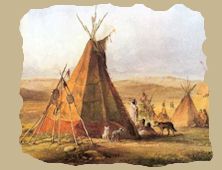|
|
When Lewis and Clark visited Oregon and Idaho in 1805, they found
there a proud, fierce tribe known as the Nez Perce. A highly
independent people, the Nes Perce remained friendly to the white men
during most of their history until the Nez Perce War of 1877, an
uprising which made the name of Chief Joseph famous. It is the
belief of some historians that Chief Joseph actually was a
"figurehead" was leader in as much as the social structure of the
tribe provided each band with several chiefs.
In a treaty in 1855, the tribe was given a reservation which
included the Wallowa Valley of Oregon and considerable land in
Idaho. When these areas became desirable to settlers and miner, a
new treaty was made in 1863 shunting the tribe off to a reservation
in Idaho. The Nez Perce bands living in the Wallowa Valley refused
to leaved their traditional home and the leading chief, the elderly
Chief Joseph was joined by several other chiefs and by his son who
born the same name, in refusing to sign the treaty.
The old chief died in 1872, insisting to the last that his followers
remain in the Wallowa Valley and never sell their homes to the white
men. Young Joseph, then in his mid-thirties, was opposed to war and
went reluctantly along with plans to remove his people to the Lapwai
Reservation in Idaho. Before the negotiations could be concluded,
the tribe was victimized by some of the white settlers who wanted to
drive the Indians from the valley by force. War was inevitable; the
warriors of the Nes Perce attacked a settlement and U.S. Army troops
moved swiftly into the valley.
For a peace-loving man, Chief Joseph proved a remarkable general.
With several bands of the tribe gathered in a rocky canyon. Chief
Joseph began moving his people into the mountains. Harassed by
superior numbers and by the necessity of taking along their women,
children and old ones, the Nez Perce utilized their knowledge of the
mountainous terrain to keep the soldiers from overwhelming them. In
fact, the Indians were victorious in several of the one sided
encounters. During the retreat Chief Joseph's wife gave birth to a
daughter.
More and more troops were sent against the Nez Perce. No less an
Indian-fighter than Colonel Nelson A. Miles brought in troops from
the north in an attempt to cut off the tribe's attempts to reach the
Canadian border. General Howard's troops followed the Indians with
the tenacity of hounds while Colonel Sturgis' force of Indian
soldiers and scouts drove at the flank of the Nez Perce.
Joseph's people managed to fight their way across Idaho and deep
into Montana. On the Milk River, near Montana's Bear Paw Mountains,
they fought Miles' detachment day after day in one of fiercest and
most prolonged engagements of any Indian war. At this point the
Canadian border was less than fifty miles distant. Eventually it
appeared that the Indians would break through to freedom, but fresh
troops arrived in time to cut off their advance. The Nez Perce were
forced to surrender on October 5, 1877, brought to bay by
overwhelming odds.
The band numbered 431 when Chief Joseph and his people were sent ot
Fort Leavenworth, Kansas, and then to Indian Territory, a land far
different from the mountains and valleys of their ancestral home.
About six years later 33 of the women and children were allowed to
return to Idaho, and in the next year 118 more Nez Perces returned
home. Chief Joseph and some 150 others were not allowed to go to
Idaho, later being sent to the Colville Reservation in Washington
state.
Chief Joseph was quite a celebrity because of the fame of the Nez
Perce uprising and his remarkable handling of the campaign. In 1903
he went to Washington D.C. and visited President Theodore Roosevelt
and renewed his acquaintance with Miles-now a general. The following
year, on September 21, 1904, he died at Nespelim, on the Colvill
Reservation.
The books presented are for their historical value only and are
not the opinions of the Webmasters of the site.
Collection of books and papers, 1922-1925
Indian Warriors
|

